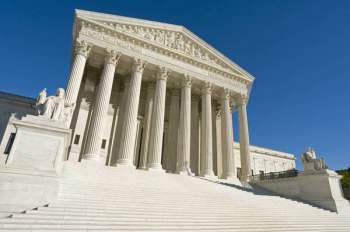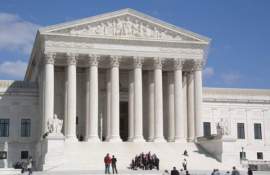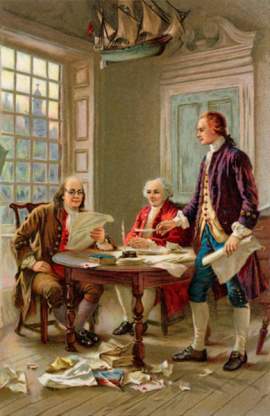
The Supreme Court Defined

The creation of the United States Supreme Court came about through Article III, on "The Judicial Branch," of the Constitution. The essential concept of a United States Supreme Court is dealt with in Section 1, "Judicial powers," while the operation of the United States Supreme Court toward the American legal system as a whole is dealt with in Section 2, "Trial by Jury, Original Jurisdiction, Jury Trials." While all of the subsequent shapes and functions which have been taken by the United States Supreme Court have derived their Constitutional basis from these sections, the language they contain, as is the case throughout the Constitution, are broad enough to allow for flexibility in interpretation and responding to new challenges.
The manner in which these generally understood terms have affected American history has often been determined by their earliest implementation. The Constitution suggested the scope of powers to be allowed to a United States Supreme Court, for instance, by specifying "Cases" and "Controversies." The pertinence of these rules to the actual United States Supreme Court, however, was established by the Chief Justice himself, John Jay, when he pointedly turned down the chance to comment on President Washington's foreign policy.
Jay thus established that the United States Supreme Court should not extend beyond rendering case judgments to deciding general Government policy. The Constitution had previously provided against the entanglement of the United States Supreme Court in political skirmishes by mandating that Justices could serve "during good Behavior". In practice, this stipulation has been interpreted as setting a life term.
The United States Supreme Court at once reflects the concerns and established practices of its time and allows for the institution to respond to issues of which the Founding Fathers could scarcely have conceived. As an example of the former point, the belief in the need for a United States Supreme Court came in part from the theory of the separation of powers as an aspect of governance.
The concept had previously been written about by the French Enlightenment philosopher Montesquieu and implemented to a limited extent in the English political structure. In order for the United States Supreme Court to play its part in realizing this principle, the idea of "judicial review" was invoked.
The Constitution itself does not address judicial review. It was, however, on the minds of the Founding Fathers, as shown by references to the concept appearing in the Federalist Papers and the creation of a United States Supreme Court was in part aimed at this function. Moreover, the practicability of judicial oversight had already been demonstrated by its use in individual State courts.
As it was not directly set out in the Constitution, however, judicial oversight was not immediately claimed as a right by the Supreme Court, awaiting 1803 and Chief Justice John Marshall's opinion on the case of Marbury v. Madison. Four separate Chief Justice appointments were made in the Supreme Court's first decade, the last of which, John Marshall, marking the decision both for longer terms for that office and greater power in general for the Court.
NEXT: What You Need To Know About SC Cases On Failing to Protect Individual Rights




















